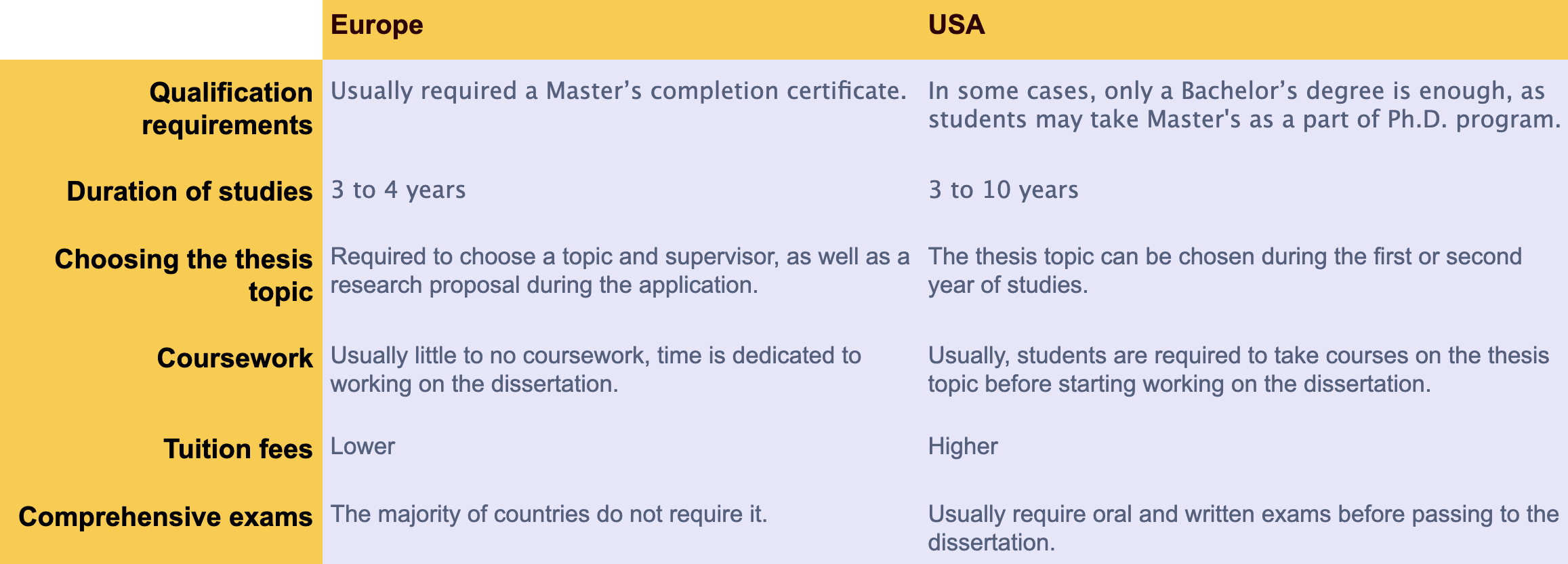Luckily, a portion of the world population has a forever appetite for studies and new knowledge. Those people with higher academic potential drive progress to our daily lives through numerous researches and innovations.
There are genius people who do not need specific academic education and environment to make a breakthrough. However, the usual path for reaching high authority and expertise in a field lies in completing quality education steps.
As mentioned in our previous article on differences between undergraduate and graduate studies, a Master's degree assumes a person has advanced skills in his profession. A Master's degree allows students to enter higher positions in the employment market and be eligible for better career opportunities.
However, perfection has no limits. Here comes the next level of graduate education for those who want to be more than good professionals. A Doctorate is the highest level of an academic degree one can get in their field. This stage is designed for students to continue their academic careers and develop their unique concepts and innovations.
The way one could upgrade their academic degree to the highest differs from country to country. Due to the educational system reforms, historical approaches, and other factors, doctorate structures vary in different parts of the world.
There are variations in general structure, admission requirements, study duration, etc. Therefore, consider exploring all the possible opportunities before deciding on your Ph.D. program, as the approach is not the same everywhere.
Every country and university have their specifications and are subject to personal, thorough research before applying. This article discusses the notable differences between Russia & CIS countries, Europe, and the US to give you a base for further navigation.
You are going to read:
1. What is a doctorate?
2. Doctorate structure in Russia and CIS countries.
3. Doctorate structure in European countries and the US.
What is a doctorate?
A doctorate is the highest academic degree one can have in any sphere. It is informally subdivided into Ph.D. ( Doctor of Philosophy) and applied doctorates. Those two are of the same academic status and importance, with minor differences in the nature of studies and further career applications.
What is a Ph.D. ?
Ph.D. stands for Doctor of Philosophy. You may also meet this term under the title Research Doctor's degree or Research Doctorate, which describes the degree's idea.
Ph.D. is an academic degree focused on original research and data analysis. Its main purpose is to create new knowledge through independent study. To complete a Ph.D., one should present and defend a dissertation on a new and unstudied topic before in the specific field.
During the Ph.D. studies, students follow the following chain of actions:
-
Carefully analyze the already existing researches in the field
-
Identify the existing knowledge gaps to choose a topic for personal research
-
Conduct an original research
-
Prepare a dissertation (usually 70,000-100,000 words)
-
Present and defend it to an academic audience and topic stakeholders
Usually, people with PhDs continue their careers in the research or education sphere. Some universities even have a Ph.D. as the main employment requirement.
Applied Doctorate Degrees
Besides Ph.D., mostly focusing on research and enrichment of knowledge, there are opportunities to hold a doctorate in almost all areas. The title Applied indicates those doctorate degrees are usually for certain professions and are purposed for more practical applications of the existing research.
Other than Ph.D., the main types of doctorate degrees include Doctor of Business Administration (DBA), Doctor of Education (EdD), Doctor of Architecture (DArch), Doctor of Medicine (DM), Juris Doctor (JD), etc.
Doctorate students complete the following chain of actions:
1. Evaluate the effectiveness of existing practices in the field
2. Choose the topic of focus among the identified problems in the working processes
3. Formulate the implementation plan of either current theories or a new one to solve real existing problems in the field
4. Make a dissertation ( 70,000- 100,000 words)
5. Organize and present the implementation test results to an academic audience and problem stakeholders
Applied Doctorate Degrees usually lead to a professional career upgrade, as students become more specialized in their working practices. For some high corporate positions, it can even be required to take a Doctorate.
You may be interested in Distance learning PHD programs.
Differences in Doctorate structure among countries
Each doctorate procedure may have its specifications based on the country and specific university, as mentioned above. Usually, Doctorate is considered the last and highest academic degree after the Master's, and one can apply to it with the completion certificate of the Master's degree.
More specifically, the below sections present the Doctorate structure and procedures in different locations.
Doctorate in Russia and CIS countries
In the mentioned group of countries, there are two academic grades pursued after the Master's degree: the Candidate of Sciences and Doctor of Sciences. This division of doctorate structure is inherited from the former Soviet Union approach. It's worth noting that unlike other European countries, Germany has the same doctorate structure.
In the Western Scientific Hierarchy, a candidate of science is viewed as equivalent to Ph.D. According to the International Standard Classification of Education, the Candidate of Sciences belongs to level-8- "doctoral or equivalent."
However, Candidate and Doctor statuses are divided with a certain level of importance and opportunities they give.
Candidate of Sciences is viewed as similar to Ph.D., DPhill, LLD, etc. Usually, the career perspective of Candidates of Science is the Associate Professor. Doctor of Science is gained after the Candidate of Science and is viewed as a more valuable degree, similar to Doctor of Natural Sciences (DSc), Doctor of Humanities (DLitt), etc. The Doctor's degree allows for becoming a full professor.
Students are allowed to apply for a Doctorate strictly after completing the Master's level of education in those countries. Usually, it takes two years for each degree to complete.
Explore Ph.D. program opportunities in Russia.
Doctorate in Europe and US
The above mentioned two-grounded system for Doctorate is hosted outside the EU countries and the US. There is one full doctorate study program for these countries that provides the student with the highest academic achievement.
However, within this unanimous conceptual approach, Europe and the US have differences in doctorate study procedures, which might also be useful to consider.
Europe is the continent of origin for the modern doctoral degree. Doctorate studies in Europe are designed with a wide diversity of qualification and credit systems, due to which the absolute majority of European Doctorate degrees are internationally recognized and accepted. Many European universities provide additional training and development opportunities included in the doctorate study program.
Explore the Ph.D. studies opportunities in Europe.
The US is considered another destination for taking a doctorate due to the internationally famous universities and an abundance of further career opportunities. A notable difference between doctorate studies in the US and Europe is that US students are usually required to teach as a part of their studies. Also, US students typically have more supervision from their advisor professors.
Explore Ph.D. opportunities in the USA.
The below comparison chart highlights the Doctorate study main differences in Europe and the US.

Knowing the below mentioned differences in academic programs will help you to make wiser decision on where you want to upgrade your degree. You may reach the same result (highest degree) with a shorter path: less years of studies, easier admission, etc.
Use the above links to navigate among the abundance of choices for your highest degree studies.
Published on Dec 29, 2020







